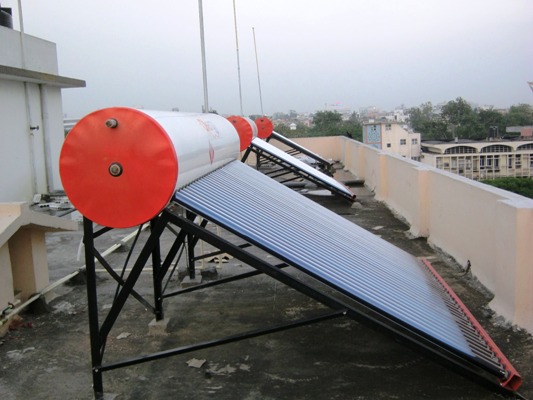India: Three New Standards – One Each for Vacuum Tube Collectors, Storage Tanks and Complete Systems
August 25, 2016
 The Bureau of Indian Standards (BIS) has published new regulations on all-glass evacuated solar collector tubes and related storage tanks of non-concentrating solar collector systems. Indian Standard (IS) 16542 : 2016 describes the storage tank’s specifications, IS 16543 : 2016 names the ones for tubes, and IS 16544 : 2016 covers the ones for complete systems. To obtain the three new standards, a company or individual will have to purchase them at BIS. Once the government notification has been published, all three will become mandatory and require that each tube or storage tank should carry the standard’s mark in addition to the manufacturer’s trademark and the batch number or date of manufacture. A transition period is to be set by the Ministry of New and Renewable Energy (MNRE). The photo shows vacuum tube systems on the roof of a block of flats in Kolkata city in eastern India.
The Bureau of Indian Standards (BIS) has published new regulations on all-glass evacuated solar collector tubes and related storage tanks of non-concentrating solar collector systems. Indian Standard (IS) 16542 : 2016 describes the storage tank’s specifications, IS 16543 : 2016 names the ones for tubes, and IS 16544 : 2016 covers the ones for complete systems. To obtain the three new standards, a company or individual will have to purchase them at BIS. Once the government notification has been published, all three will become mandatory and require that each tube or storage tank should carry the standard’s mark in addition to the manufacturer’s trademark and the batch number or date of manufacture. A transition period is to be set by the Ministry of New and Renewable Energy (MNRE). The photo shows vacuum tube systems on the roof of a block of flats in Kolkata city in eastern India.Photo: Jaideep Malaviya
According to the statistics available from the Central Board of Excise and Customs, India imports close to 4 million tubes annually, including those which are part of complete systems imported into the country. Over the past few years, a growing number of sub-standard systems has penetrated the Indian market, making domestic manufacturing unviable. The shift from manufacturing to imports, however, came at a price: lower quality and more frequent customer complaints after non-performance and breakage. The worsening situation has led to the establishment of the new standards which would strengthen customer confidence and avoid spurious items from being used in systems installed in the country.
Tube standard BI 16543 : 2016 stipulates that the selective coating of the tube must have an absorptivity of at least 0.92 and an emissivity of less than 7 %. The coating is to include three layers: an absorption layer (aluminium nitride), a bonding agent cum absorption layer (aluminium nitride – stainless steel) and an anti-reflective layer (copper). Glass tubes are to be made of borosilicate glass 3.3 in compliance with ISO 3585. The solar transmittance ratio of the glass tube must be > 0.89 (at an air mass of 1.5).
The systems will have to undergo tests for:
- Stagnation performance
- Stagnation solar irradiance
- Average thermal loss coefficient
- Vacuum performance
- Resistance to thermal shock
- Resistance to impact (e.g., a stone hitting the glass tube)
- Resistance to internal pressure
- Absorptivity and emissivity of selective coating
The storage tank standard sets the wall thickness of stainless steel to a minimum of 0.5 mm for up to 300 litres of water capacity and to 0.6 mm for above 300 litres. In case of mild steel, the tank wall is to have a minimum of 1.5 mm for up to 300 litres of water capacity and 2.0 mm for above 300.
Currently there are six test centres in India and two more will be available in the near future. The cost for collector testing ranges anywhere from Indian Rupee (INR) 10,000 to 12,000. The cost of testing complete systems is between INR 20,000 and 25,000.
BIS has also provided a simple formula for calculating the number of tubes required for a given capacity of hot water in litres, based on various diameters and lengths. The vacuum tubes can be 47, 58 and 70 mm in diameter and their length can be 1,500, 1,800, 2,000 or 2,100 mm depending on how big the hot water supply should be.
Industry heads have welcomed the standards as a promising step toward keeping the quality of systems in check, but they also emphasised the fact that it was now time for the Ministry of New and Renewable Energy (MNRE) to make the standards mandatory to get all offered systems BIS-tested.
You can purchase the standards from BIS at:


